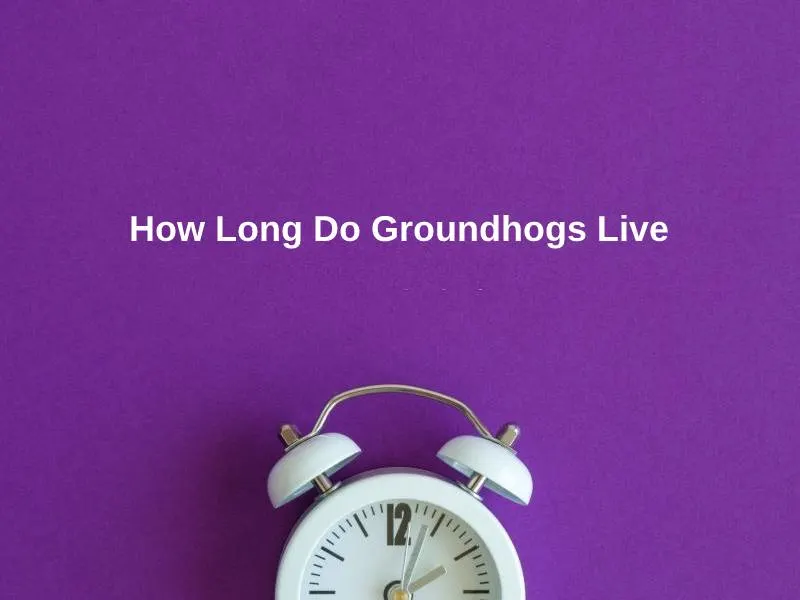Exact Answer: Up to 14 years
Groundhogs are shy animals who are said to be distant relatives of giant squirrels. They have a thick brown coat that varies in shades of brown and a 7-inch long bushy tail. Groundhogs are one of the 14 marmot species that are also called ground pig or woodchuck.
These animals are vegetarian and can easily survive on grass, green plants, buds, and bark of trees, etc. Groundhogs eat heavily in the summer season to accumulate enough fat for their winter hibernation. They can be commonly found in open areas, meadows, roads, streams, and sometimes in dense forests.
Groundpigs can create an extensive burrow system by digging dip. This characteristic makes them a nuisance for some property owners who experience property damage because of too much digging. They can also swim and climb tall shrubs or trees like their relatives.

How Long Can Groundhogs Live?
Groundhogs have a short lifespan of up to 6 years in the wild. Their short lifespan in the wild can be attributed to external factors such as predators, motors, and vehicles, and other unnatural causes. Most of them live an average lifespan of 3 years.
Groundhogs can also live for 14 years or more in captivity. Under the absence of external factors, these whistle-blowing creatures can live a long and healthy life. Most captive groundhogs pass away due to old age or old age-related sickness.
Groundhogs hibernate in late winter for 6 months and start reproducing only after their second hibernation. A mother groundhog can give birth to up to 9 babies at a time after a gestation period of approximately 30 days. Mother groundhogs can experience death because of painful gestation periods and delivery-related issues.
Groundhogs can also lose their lives to serious medical health complications such as kidney failure at a young age. These rodents also act as pathogen carriers and help spread diseases in humans.
In summary:
| Groundhogs | Lifespan |
| Wild | 6 years |
| Captive | 14 years |
Why Do Groundhogs Live So Long?
Groundhogs are tiny rodents that may live for 14 years or more if protected from unwanted circumstances. They can live a long and happy life under someone else’s supervision. Captive groundhogs mostly die because of old age and age-related sickness.
The wild groundhogs, on the contrary, have an average lifespan of 3 years. Most of them die because of predators such as coyotes, foxes, snakes, and prey birds. Wild groundhogs may also die because of road accidents or falling from tall heights. Some die because of sickness and no medical help.
Wild groundhogs may also suffer because of natural disasters. They are not very tolerant of extreme temperatures and thus, go into deep hibernation during late winters. They are small creatures that are inherently cute but not very strong in terms of physical strength.
Groundhogs also spread deadly diseases in humans. From a very early age, groundhogs have been used to spread pathogens such as the causative agent of bubonic plague, other viruses, and bacteria to achieve political agenda. They are the natural carriers of harmful microbial communities.
The advancement of medical technology has also extended the lifespan of pet groundhogs. Groundhogs may suffer from serious health issues such as kidney or lung failure. Medical advancement has helped solve such severe complications.
Conclusion
The second of February is celebrated as Groundhogs day in western Pennsylvania each year. These loving creatures are loved all over the world. They are commonly found in meadows, forests, streets, roads, and streams of eastern and western United States, Canada, and Alaska. They feed on the barks, buds, leaves, stems, and other green parts of trees and plants.
They have an average lifespan of 2 to 3 years. However, some wild groundhogs may also live up to 6 years. Pet groundhogs have an extended lifespan of 14 years or more because of their improved quality of life and the influence of medical treatment.
Groundhogs breed specifically in spring, resulting in the birth of 1 to 9 litters from each mother. The babies stay with the mother for 2 to 3 months after which they leave to find their territory. They reproduce only after a hibernation period of 150 days, during which they eat nothing and utilize resources from their own bodies.
References
- https://search.proquest.com/openview/9e64630f39adbd71df2e86e5ca062d94/1?pq-origsite=gscholar&cbl=18750
- https://www.ncbi.nlm.nih.gov/pmc/articles/pmc1802502/